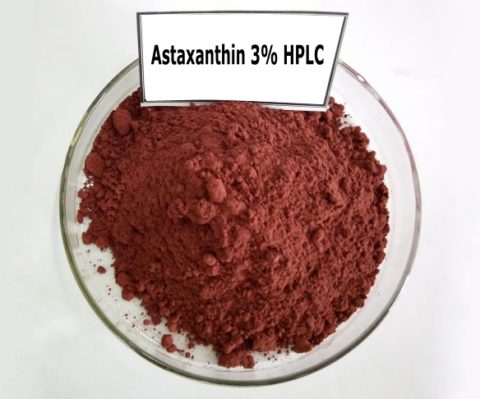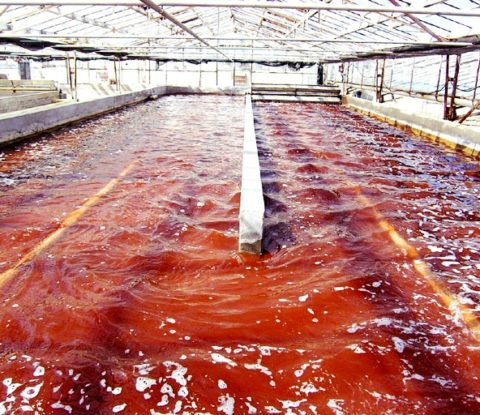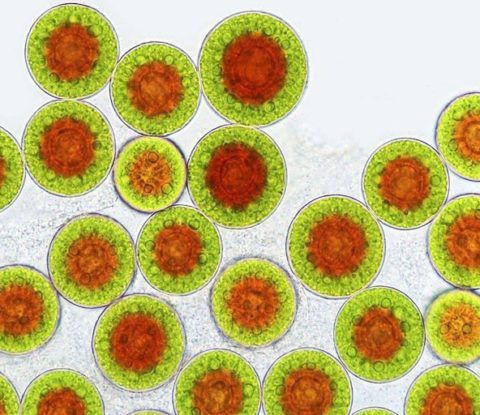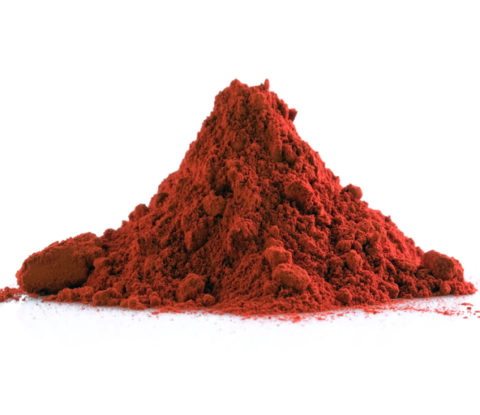
Haematococcus Pluvialis Extract, Natural Astaxanthin Powder 1.5%,3%, 5%,10% HPLC
Astaxanthin is a kind of ketone or carotenoid, pink color, fat soluble, insoluble in water, soluble in organic solvent. A red carotenoid found in aquatic animals such as crayfish shells, oysters, and salmon. Astaxanthin can be obtained by biological extraction, chemical synthesis, algae, bacteria and yeast.
Microalga Haematococcus Pluvialis Extract Astaxanthin 1%-10% Powder
【Specification】: 1.5%,3%, 5%,10% HPLC
【Use appropriate】: Protection measures to avoid direct contact
【Origin】: China
【Appearance】: Dark red powder
【Odour】:characteristic
【Particle size】: 100% pass 80 mesh
【CAS number】: 472-61-7
【Molecular formula】:C40H52O4
【Molar mass】: 596.84 g mol−1
【Benefits】: Anti-oxidant
【Particle Size】: 80 mesh
【Packing】: Packed in 25 kg/fiber drum with double plastic bags inside
【Storage】: Store in a cool&dry place away from Moisture, Light, Oxygen
【Shelf】: 24 months since the manufacturing date

What’s the Haematococcus pluvialis
Haematococcus pluvialis is a freshwater species of Chlorophyta from the family Haematococcaceae. This species is well known for its high content of the strong antioxidant astaxanthin, which is important in aquaculture, and cosmetics.
The high amount of astaxanthin is present in the resting cells, which are produced and rapidly accumulated when the environmental conditions become unfavorable for normal cell growth. Examples of such conditions include bright light, high salinity, and low availability of nutrients.
Haematococcus pluvialis is usually found in temperate regions around the world. Their resting cysts are often responsible for the blood-red colour seen in the bottom of dried out rock pools and bird baths. This colour is caused by astaxanthin which is believed to protect the resting cysts from the detrimental effect of UV-radiation, when exposed to direct sunlight.
The Relationship between Haematococcus pluvialis and Astaxanthin
Haematococcus pluvialis is a miniature single-cell green algae, with special biological properties, showing the diversity of its life cycle, with motile cells, zoospores, fixed cells and spores of four forms do not move in a weak light, nitrogen and phosphorus-rich environment mainly in the form of a green swimming cells exist in the process moderate rain pluvialis vigorous growth, the cells contain a small amount of astaxanthin; born in unfavorable conditions exist (high light high temperatures, high salt and nutrient starvation), the places fixed spores (thick-walled spores) form, this time, due to algal cells often contain large amounts of astaxanthin and appear red.
Currently, Depending Haematococcus pluvialis exist in different forms , will generally be divided into astaxanthin production of microalgae cultivation and astaxanthin accumulation–Two phases. Previous stage mainly Haematococcus pluvialis cultures, making it a high-density growth .The current stage production model have two so-called batch cultures and semi- continuous culture. Batch cultures support means for microalgae culture medium in a stable condition, Semi- continuous culture refers to the culture reached a considerable concentration of algae cells. After removing the first part of the new medium people turn algae solution stress environment , and added the same amount of continuing training every day , so Haematococcus pluvialis in solid Continuous production of the growth rate and held constant physiological characteristics stable conditions .The second stage is high illumination ,High Temperature , high salt , nutrient starvation and a series of duress to prompting changes haematococcus pluvialis to survive in the harsh environment into a thick wall spores– in order to achieve the purpose of the accumulation of astaxanthin .In both phases , microalgae nutritional requirements and environmental conditions are differents , the current our company’s haematococcus pluvialis cultivation mainly focused on these two stages choice and control conditions .
Research on Astaxanthin Benefits
All cells in our bodies are constantly exposed to reactive free radicals that are produced from smoking, irradiation, pollution and also as a by-poduct of metabolism itself. A higher level of free radical compared to antioxidants leads to increased oxidative stress in the body.Oxidative stress cause many health problems because it damages proteins, lipids, DNA and enzymes, which leads to dysfunctional cells and inflammation. Because astaxanthin is taken up by all cells in the body and reduces oxidative stress, it has demonstrated several health benefits in clinical studies. The aim of our medical research is to develop methods for the prevention and treatment of ailments caused by oxidative stress so as to improve health and quality of life.
1.Astaxanthin improves muscle endurance and recovery
Intensive physical ativity increases the level of free radicals because of a greater stress on muscle fibers and an increased metabolic level. In addition, while we age, the body will produce lower amounts of antioxidants and the muscles will be exposed to higher levels of oxidative stress. Intake of external antioxidants might therefore be beneficial for hard-training athletes as well as for older people. Astaxanthin protects muscles from free radicals and thereby enhances recovery, reduces inflammation and boosts muscle performance.
Studies on Astaxanthin indicate several positive effects for muscles.
– Enhances muscle endurance.
– Lowers lactic acid in muscles.
– Protects the cell’s “energy stations” (mitochondria) form oxidation, which results in more energy for muscles.
2.Astaxanthin makes tired eyes alert
We are spending more time in front of computers and as a consequence there is growing number of people suffering from eye fatigue. The symptoms of eye fatigue include eye strain, irritation, sore and dry eyes and frequent headaches.
Overstrained eye muscle responsible for regulating the lens is considered the main factor for eye fatigue. Astaxanthin protects these muscle from oxidation and by so doing has positive effects for eye health.
Studies on astaxanthin indicate several positive effects for the eye
– Reduces problems caused by eye fatigue.
– Improve the capacity of the eyes to accommodate to changing focal distances.
– Increase blood transportation to the eyes.
3.Beautiful skin with astaxanthin
The skin needs strong protection because it is always exposed to environmental pollution and UV-light, which increase the level of free radicals in the skin. Aging leads to reduced levels of antioxidants in the skin, which is therefore more dependent on antioxidants from food. Astaxanthin has been shown to give a superior protection to skin cells and it contributes to a healthier skin.
Studies on astaxanthin indicate several positive effects for the skin.
– Reduces fine lines and wrinkles.
– Improves elasticity the skin by strengthening the collagen layer.
– Increase moisture content of the skin.
4.Astaxanthin increase likelihood of getting pregnant
Oxidative stress reduces sperm quality, which can cause infertility. Free radicals damage the cell membrane of the sperm, which decrease sperm motility and its ability to fuse with an egg. Astaxanthin reduces these harms thanks to its ability to protect the sperm cell membrane from oxidation.
In a double blind, randomized study, 30 couples with infertility problems participated and the men were treated with astaxanthin or placebo. In the astaxanthin group, 54.5% of the couples were pregnant within three months, whereas only 5.4% in the placebo group had a baby. The men supplemented with astaxanthin had significantly lower oxidative stress in their sperm and an increased sperm quality compared to the placebo group. Similar results were also found for horses and pigs that were supplemented with astaxanthin in their feed.
5.Astaxanthin keeps you healthy and alert
A well-functioning immune system that responds rapidly to viruses and bacteria is important for avoiding colds and flus. The immune cells are particularly sensitive to oxidative stress because their cell membranes contain a high level of unsaturated fatty acids. Oxidation of the immune cell’s membranes leads to a reduced immune response. Astaxanthin inhibits this oxidation and by so doing may enhance the immune system.
Studies on astaxanthin indicate several positive effects for the immune system.
-Boosts the immune system so it reacts faster to viruses and bacteria.
-Increase the number of white blood cells.
-Improves the capacity of white blood cells (neutrophils) to attack invaders.
6.Astaxanthin makes your stomach happy
Common stomach problems include swollen stomach, pain, nausea and heartburn. Indivials who often have these problems tend to have increased inflammation in the stomach and, in many cases, an infection caused of the bacterium Helicobacter pylori. The traditional view that astaxanthin is mainly accumulated mainly in the thick-walled spore phase .However, recent studies have shown that the accumulation of rain pluvialis astaxanthin does not depend on cell division stops, thick-walled spore formation and cell movement can Power loss, the accumulation of astaxanthin can occur in Haematococcus vegetative growth period, and the cells are able to swim as fast and thick-walled spores degree, a large number of synthetic astaxanthin.








